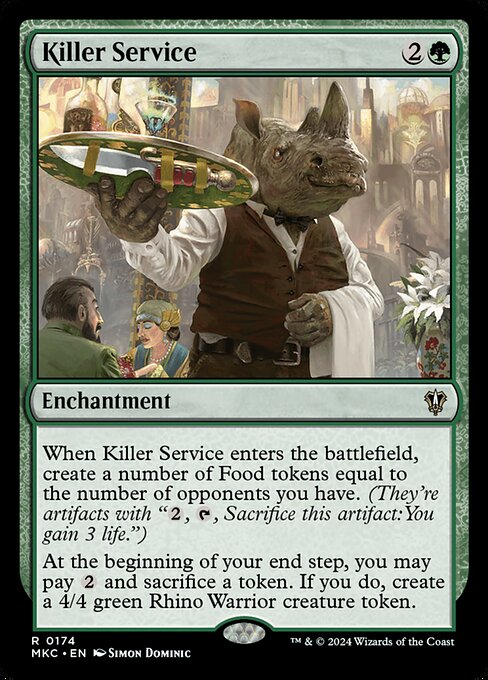
Image courtesy of Scryfall.com
Art and the Set’s Visual Identity
In Murders at Karlov Manor Commander, the green mana identity meets a gothic, candlelit atmosphere that feels equal parts manor-house intrigue and garden-thriving forest. Killer Service leans into that visual ethos by pairing a verdant color language with a flavor that hints at abundance, ritual, and the quiet tension of a table where every plate could conceal a plot. The illustration — brought to life by Simon Dominic — works as a mirror to the set’s overarching vibe: nature’s generosity under a veneer of sophisticated mystery. The piece invites you to lean in closer, to notice the glint of life and the promise of resources waiting to be tapped, much like green mana itself that invites growth and resilience. 🧙♂️🔥
The set’s frame and aesthetic—listed as Frame 2015 with a black border and an oval security stamp—sit comfortably in Commander’s modern storytelling era. That design language influences more than just the card borders; it guides how gameplay concepts are presented visually. When you see Killer Service, you’re primed to expect green’s hallmark motifs: growth, provisioning, and a kind of organic ecosystem where tokens become the engine of late-game power. The art doesn’t shout a single mechanic; it whispers a mood—lush, a touch ominous, and irresistibly ceremonial—so that the card’s textual flavor lands with a satisfying thematic thud. 🎨🎲
Flavor, Tokens, and Thematic Cohesion
At the surface, Killer Service is an enchantment with a deceptively simple premise: you enter with a token-generating spark that scales with your opponents, then you get a recurring payoff at end step if you’re willing to invest again. The core flavor—the “service” that feeds and sustains your party—fits green’s identity of provisioning and growth. The Food tokens, artifacts that grant life when sacrificed, are not just mechanical resources; they are a tactile nod to the manor’s feasting culture and the idea that provisioning can be a strategic weapon as well as a source of sustenance. In a multiplayer Command Zone, the ability to spawn Food tokens proportional to the number of opponents immediately creates a sense of scale, drawing players into a cooperative-feel game where green’s ecosystem is steadily expanding. ⚔️💎
Crafted for a communal setting, the artwork and the card’s mechanics reinforce green’s long-running narrative: nature as an abundant, communal resource that inflates the board state when you lean on it. This isn’t just about big creatures; it’s about the rhythm of play—build, feed, and unleash—echoing the social tempo of a tabletop night at Karlov Manor. 🧙♂️
Mechanics as Visual Signals
The text on the card is a concise treatment of a larger design philosophy: green loves growth, tokens, and big finishers. When Killer Service enters the battlefield, you create a number of Food tokens equal to the number of opponents you have. In a typical Commander session with four players, that’s up to three Food tokens right off the bat, each token a potential source of life and a future sacrificial engine. At the end step, the option to pay two mana and sacrifice a token to conjure a 4/4 green Rhino Warrior token reinforces green’s affinity for large creatures that feel both organic and inevitable. The visual language of the art—lush greens, textured foliage, and a hint of the manor’s opulent abundance—matches the idea of green using “resources” (in this case, Food) to grow a formidable board presence. 🧙♂️🔥
From a design perspective, the card’s rarity (rare) and its color identity (green) pair nicely with the set’s Commander focus. In MKC, survivability and tempo hinge on a steady stream of bodies and life—Food tokens not only reward you with life but also fuel the end-step engine that can swing games in a single, satisfying moment. The Rhino Warrior token that could emerge later is not just a threat; it’s a visual payoff that echoes the art’s lush, forest-forward vibe and the set’s storytelling about symbiotic, if occasionally hazardous, hospitality. This synergy between image, motif, and function helps unify the set’s visual identity and the player’s experience. 🎲🎯
Art, Value, and Collectibility in a Commander World
The card’s illustration credits (Simon Dominic) and its 2015-inspired frame work within a modern Commander context give Killer Service a distinct, collectible aura. While its price tag sits in an accessible range for many players, its value lies in how well it slots into green-heavy commander strategies that revel in token generation, life-sustain mechanics, and big payoff turns. The card’s EDHREC rank hovering around the mid-range of 5,311 reflects its role as a dependable, thematically rich choice rather than a one-off in a niche build. For players who love lore that marries manor intrigue with the organic vigor of green, Killer Service feels like a natural fit. And for collectors, its art and its set’s cohesive visual identity offer a snapshot of a specific storytelling moment within the Murders at Karlov Manor mythos. 🧙♂️💎
As a piece of the MKC mosaic, Killer Service also embodies the cross-promotional energy collections can carry. The set’s narrative threads, the green token economy, and the grand tableaus depicted in the art invite players to imagine a larger world—one where every service rendered could tip the balance of power in a multi-player duel or a sprawling kitchen-table campaign. The visual identity isn’t just about pretty pictures; it’s about evoking a shared mood that anchors strategies, flavor text, and the cadence of play. And that, dear readers, is the magic of well-crafted card art in a world where you can almost hear the rustle of forest leaves behind the manor doors. 🧙♂️🎨